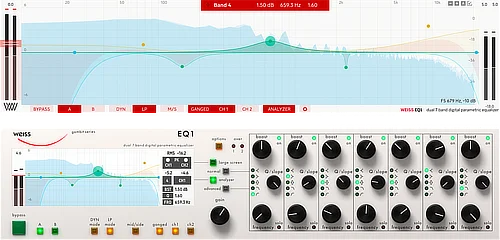Use Weiss EQ1 to sculpt the tonal qualities of any audio material without generating the artifacts typically produced by other equalisers, be they analogue or digital.
Basic Weiss EQ1 functions
The Weiss EQ1 is available in four different configurations. The basic model is the EQ1-MK2, the linear phase model is the EQ1-LP, and the dynamic model is the EQ1-DYN. Lastly, the EQ1-DYN-LP incorporates both LP and DYN versions in one unit. All models are user-upgradeable to any other version.
The Weiss EQ1’s basic features are common to all four models, namely the seven identical parametric bands that cover the entire audio frequency range. Each band has Boost/Cut, Frequency, and Q/Slope knobs and operates in any of the following modes: High shelving, low shelving, peaking, high cut, low cut, or bypass.
Snapshots, MIDI, Metering
Other basic features are an A/B compare memory, a 128-position snapshot bank with two additional banks for back-up (can also be dumped/recovered via MIDI), a peak meter with over indicators, MIDI control for each parameter, a bypass switch, a gain control, and a channel ganging switch.
M/S Mode
The Weiss EQ1 can be switched to M/S mode which is especially useful for the dynamic model of the Weiss EQ1. Other specialties are variable slope shelving filters and very high-Q (up to 650) peaking filters for notching out offending frequencies.
Controls, Display
There are three knobs for each of the seven bands, in order to provide “one knob per parameter” operation. The knobs are touch-sensitive which triggers the LCD to display the parameters of the touched band. The LCD shows the overall frequency response, the detailed parameter values, and various status information.
Signal processing, Connectivity
The internal processing is done at 88.2 or 96 kHz in a 40 Bit floating-point format. A very low noise filter architecture optimised for audio is used. The digital input/output are in AES/EBU format on XLR connectors. The AES/EBU output can be POW-R dithered to 16, 20 or 24 Bits.




